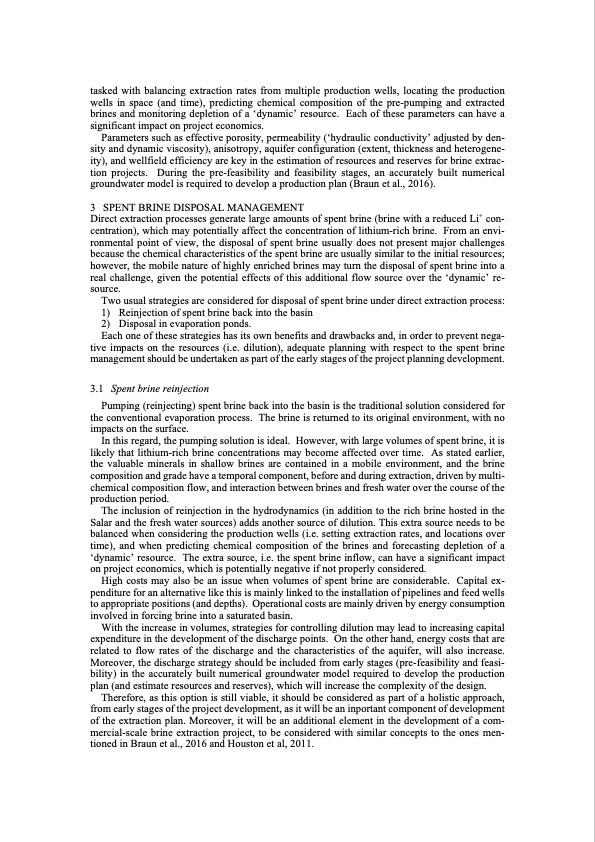
PDF Publication Title:
Text from PDF Page: 004
tasked with balancing extraction rates from multiple production wells, locating the production wells in space (and time), predicting chemical composition of the pre‐pumping and extracted brines and monitoring depletion of a ‘dynamic’ resource. Each of these parameters can have a significant impact on project economics. Parameters such as effective porosity, permeability (‘hydraulic conductivity’ adjusted by den- sity and dynamic viscosity), anisotropy, aquifer configuration (extent, thickness and heterogene- ity), and wellfield efficiency are key in the estimation of resources and reserves for brine extrac- tion projects. During the pre-feasibility and feasibility stages, an accurately built numerical groundwater model is required to develop a production plan (Braun et al., 2016). 3 SPENT BRINE DISPOSAL MANAGEMENT Direct extraction processes generate large amounts of spent brine (brine with a reduced Li+ con- centration), which may potentially affect the concentration of lithium-rich brine. From an envi- ronmental point of view, the disposal of spent brine usually does not present major challenges because the chemical characteristics of the spent brine are usually similar to the initial resources; however, the mobile nature of highly enriched brines may turn the disposal of spent brine into a real challenge, given the potential effects of this additional flow source over the ‘dynamic’ re- source. Two usual strategies are considered for disposal of spent brine under direct extraction process: 1) Reinjection of spent brine back into the basin 2) Disposal in evaporation ponds. Each one of these strategies has its own benefits and drawbacks and, in order to prevent nega- tive impacts on the resources (i.e. dilution), adequate planning with respect to the spent brine management should be undertaken as part of the early stages of the project planning development. 3.1 Spent brine reinjection Pumping (reinjecting) spent brine back into the basin is the traditional solution considered for the conventional evaporation process. The brine is returned to its original environment, with no impacts on the surface. In this regard, the pumping solution is ideal. However, with large volumes of spent brine, it is likely that lithium-rich brine concentrations may become affected over time. As stated earlier, the valuable minerals in shallow brines are contained in a mobile environment, and the brine composition and grade have a temporal component, before and during extraction, driven by multi‐ chemical composition flow, and interaction between brines and fresh water over the course of the production period. The inclusion of reinjection in the hydrodynamics (in addition to the rich brine hosted in the Salar and the fresh water sources) adds another source of dilution. This extra source needs to be balanced when considering the production wells (i.e. setting extraction rates, and locations over time), and when predicting chemical composition of the brines and forecasting depletion of a ‘dynamic’ resource. The extra source, i.e. the spent brine inflow, can have a significant impact on project economics, which is potentially negative if not properly considered. High costs may also be an issue when volumes of spent brine are considerable. Capital ex- penditure for an alternative like this is mainly linked to the installation of pipelines and feed wells to appropriate positions (and depths). Operational costs are mainly driven by energy consumption involved in forcing brine into a saturated basin. With the increase in volumes, strategies for controlling dilution may lead to increasing capital expenditure in the development of the discharge points. On the other hand, energy costs that are related to flow rates of the discharge and the characteristics of the aquifer, will also increase. Moreover, the discharge strategy should be included from early stages (pre-feasibility and feasi- bility) in the accurately built numerical groundwater model required to develop the production plan (and estimate resources and reserves), which will increase the complexity of the design. Therefore, as this option is still viable, it should be considered as part of a holistic approach, from early stages of the project development, as it will be an inportant component of development of the extraction plan. Moreover, it will be an additional element in the development of a com- mercial‐scale brine extraction project, to be considered with similar concepts to the ones men- tioned in Braun et al., 2016 and Houston et al, 2011.PDF Image | Direct extraction lithium processes

PDF Search Title:
Direct extraction lithium processesOriginal File Name Searched:
Ezama-Hoyos-Cortegoso-Braun-Spent_Brine_Disposal-TMW_Paper20191128190251287.pdfDIY PDF Search: Google It | Yahoo | Bing
Product and Development Focus for Infinity Turbine
ORC Waste Heat Turbine and ORC System Build Plans: All turbine plans are $10,000 each. This allows you to build a system and then consider licensing for production after you have completed and tested a unit.Redox Flow Battery Technology: With the advent of the new USA tax credits for producing and selling batteries ($35/kW) we are focussing on a simple flow battery using shipping containers as the modular electrolyte storage units with tax credits up to $140,000 per system. Our main focus is on the salt battery. This battery can be used for both thermal and electrical storage applications. We call it the Cogeneration Battery or Cogen Battery. One project is converting salt (brine) based water conditioners to simultaneously produce power. In addition, there are many opportunities to extract Lithium from brine (salt lakes, groundwater, and producer water).Salt water or brine are huge sources for lithium. Most of the worlds lithium is acquired from a brine source. It's even in seawater in a low concentration. Brine is also a byproduct of huge powerplants, which can now use that as an electrolyte and a huge flow battery (which allows storage at the source).We welcome any business and equipment inquiries, as well as licensing our turbines for manufacturing.| CONTACT TEL: 608-238-6001 Email: greg@infinityturbine.com | RSS | AMP |